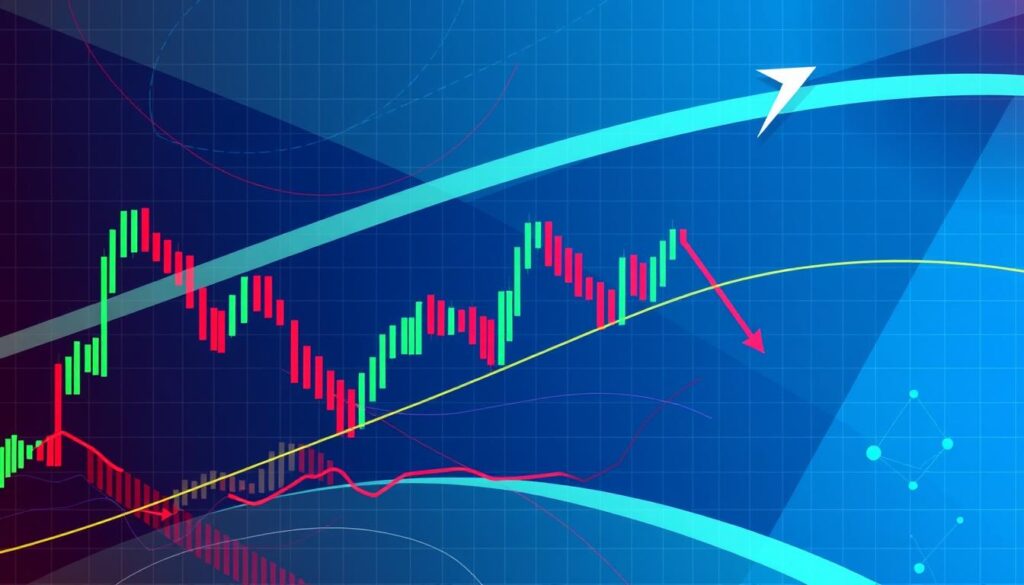How to Use Technical Analysis for Stock Market Investing
The stock market is full of ups and downs. To succeed, you need a strong strategy.
Anúncios
Technical analysis is a key tool that helps you find valuable insights from market data and trends. This guide will show you how to use technical analysis to improve your investing skills.
What is Technical Analysis?

Technical analysis is a key strategy in investing. It looks at past market data, like price and volume, to spot trends. This helps investors make smart trading choices. It’s different from fundamental analysis, which looks at a company’s financial health.
Defining Technical Analysis
At its heart, technical analysis definition is about studying past market data. This includes prices, volumes, and other stats to find investment opportunities.
Anúncios
Analysts think market feelings and psychology show in stock prices. By looking at these patterns, they can predict the market’s future.
Importance of Technical Analysis in Investing
Technical analysis in investing is popular because it’s based on data. It uses price charts and indicators to find support and resistance levels. This helps investors make strategic decisions. It’s great for short-term and swing trading, focusing on market mood and trends.
“Technical analysis is a method of evaluating securities by analyzing the statistics generated by market activity, such as past prices and volume. Technical analysts do not attempt to measure a security’s intrinsic value, but instead use charts and other tools to identify patterns that can suggest future activity.”
– Investopedia
| Characteristic | Technical Analysis | Fundamental Analysis |
|---|---|---|
| Focus | Historical price and volume data | Company’s financial and economic factors |
| Objective | Identify trends and patterns to predict future price movements | Determine a company’s intrinsic value |
| Time Horizon | Short-term and medium-term | Long-term |
| Key Metrics | Price, volume, support and resistance levels, moving averages | Earnings, revenue, dividends, growth rates, P/E ratio |
Understanding Price Charts
Price charts are key in technical analysis. They show an asset’s past price movements. This helps investors see trends, patterns, and key levels that guide their choices.
Learning to read stock market price charts is vital. Knowing different chart types helps investors find important information. This information shapes their investment plans.
- Line charts: These basic charts plot an asset’s closing prices over time, making it easy to identify overall trends and price movements.
- Bar charts: Bar charts display the open, high, low, and close prices for a given time period, providing a more detailed view of the asset’s trading range.
- Candlestick charts: Candlestick charts combine the information of bar charts with a visual representation of the asset’s price action, making it easier to identify patterns and potential reversals.
By studying these stock market price charts, investors gain insights into an asset’s past and future. This knowledge is key for making smart technical analysis charts and investment choices.
“The secret to being successful from a trading perspective is to have an inoperable relationship with the market.” – Paul Tudor Jones
Knowing how to read how to read stock charts is essential. It helps investors use technical analysis to find profitable trades and investments.
Key Technical Indicators
Stock market investing relies heavily on technical analysis tools. These tools help investors spot trends and make smart trading choices. Moving averages and the Relative Strength Index (RSI) are two key indicators used for this purpose.
Moving Averages
Moving averages are a top choice for investors. They smooth out price swings and show market trends. By averaging an asset’s price over time, they help traders see where the market is headed.
There are different types of moving averages. Simple moving averages (SMA) and exponential moving averages (EMA) each have their own uses.
Relative Strength Index (RSI)
The Relative Strength Index (RSI) is another key tool. It measures an asset’s price momentum. The RSI ranges from 0 to 100, showing when an asset might be overbought or oversold.
Investors use the RSI to spot buying and selling opportunities. It also helps confirm market trends.
By mastering these technical analysis indicators, investors can better understand the stock market. This knowledge helps them make more informed investment decisions.
“Technical analysis is a valuable tool for investors, but it should be used in conjunction with other investment strategies and fundamental analysis to make the most informed decisions.”
Trend Analysis
Trend analysis is key in technical analysis. It helps investors see the market’s direction or a stock’s path. By spotting uptrends, downtrends, and support and resistance levels, traders get insights into market mood and future prices.
Identifying Uptrends and Downtrends
Uptrends show a series of higher highs and higher lows, meaning the market is bullish. On the other hand, downtrends have lower highs and lower lows, showing a bearish trend. Knowing these trend analysis patterns helps traders make smart investment choices.
Support and Resistance Levels
Support and resistance levels are important in technical analysis. Support levels are where prices tend to stabilize, while resistance levels are where prices might face selling pressure. Spotting these support and resistance levels helps traders plan when to buy or sell.
Understanding trend analysis, including uptrends, downtrends, and support and resistance levels, boosts investors’ skills. It helps them make better decisions in the stock market.
Stock Market Investing with Technical Analysis
Using technical analysis in your stock market strategy can give you an edge. It helps you spot good times to buy and sell by looking at charts and indicators. This way, you can manage risks and make smarter choices.
Technical analysis for stock investing is great for finding trends. By studying price charts, you can see where the market is going. This lets you buy low and sell high, following the market’s flow.
Indicators like moving averages and the Relative Strength Index (RSI) are also key. They show a stock’s strength and momentum. This info helps you decide when to buy or sell, making your choices more informed.
- Identify and follow market trends using technical analysis.
- Utilize indicators like moving averages and RSI to gauge the strength and momentum of stocks.
- Manage risk by setting appropriate stop-loss orders and position sizes.
- Combine technical analysis with fundamental analysis for a more comprehensive investment approach.
“Technical analysis is like having a professional trader in your pocket, guiding you through the complexities of the stock market.”
Adding technical analysis to your stock market strategy can help you stand out. It leads to better decisions and outcomes in your investments.
Chart Patterns
Technical analysis is key for stock market investing. Identifying chart patterns is a big part of this. These patterns on price charts give clues about future price moves. They help investors make better trading choices.
Head and Shoulders Pattern
The head and shoulders pattern is well-known in technical analysis. It has three peaks, with the middle peak being the highest. This pattern can show a trend change, especially when the price drops below a certain line.
Double Top and Double Bottom Patterns
Double top and double bottom patterns are also important. The double top happens when a price hits a high, falls back, and then tries to hit the same high again but fails. This might mean a bearish trend. On the other hand, the double bottom pattern shows a price hitting a low, falling back, and then rebounding. This could signal a bullish trend.
Knowing these patterns is vital for investors using technical analysis. By spotting these patterns, traders can guess market trends better. This helps them make smarter trading choices.

| Chart Pattern | Description | Potential Signal |
|---|---|---|
| Head and Shoulders | Three peaks, with the middle peak being the highest | Bearish reversal |
| Double Top | Price reaches a high, retreats, and attempts to reach the same high again, only to be rejected | Bearish reversal |
| Double Bottom | Price reaches a low, retreats, and attempts to reach the same low again, only to rebound | Bullish reversal |
Combining Technical and Fundamental Analysis
Successful stock market investors use a special integrated investment approach. This method mixes technical analysis and fundamental analysis. Technical analysis looks at market data and price changes. Fundamental analysis checks a company’s financial health and industry trends.
By using both, investors get a full picture of the market. They can spot good investment chances. This way, they make smarter choices.
The combining technical and fundamental analysis method is powerful. It lets investors use the best of both worlds. They understand a stock’s real value and growth potential better.
Advantages of the Integrated Approach
- Provides a more holistic view of the market and individual stocks
- Helps identify potential investment opportunities that may be overlooked by a single-focused analysis
- Allows for the identification of trends, patterns, and underlying financial strength
- Enhances the ability to manage risk and make more informed investment decisions
| Metric | Technical Analysis | Fundamental Analysis |
|---|---|---|
| Focus | Market data and price movements | Company’s financial health, industry trends, and underlying factors |
| Timeframe | Short-term and medium-term | Long-term |
| Objective | Identify buy and sell signals, trends, and trading opportunities | Assess the intrinsic value of a company and its growth potential |
By combining technical and fundamental analysis, investors get a strong integrated investment approach. This method uses the best of both worlds. It leads to smarter and more profitable choices.
Risk Management Strategies
Effective risk management is key when using technical analysis for stock market investing. Strategies like stop-loss orders and proper position sizing help limit losses. They protect capital while seeking profitable trades.
Stop-Loss Orders
Stop-loss orders are a valuable tool in risk management in stock investing. These orders sell a stock when it hits a set price. This limits downside risk and prevents big losses. By setting right stop-loss levels, investors can handle market volatility and unexpected price swings.
Position Sizing
Another key part of technical analysis risk management is position sizing. It’s about figuring out how much capital to use for each trade. This depends on risk tolerance, account size, and market conditions. Using position sizing strategies helps avoid over-exposure. It ensures potential losses are manageable, even with market uncertainties.
| Strategies | Description | Benefits |
|---|---|---|
| Stop-Loss Orders | Automatically sell a stock when it reaches a predetermined price | Limit downside risk and prevent significant losses |
| Position Sizing | Determine the appropriate amount of capital to allocate to each trade | Avoid over-exposure and ensure manageable potential losses |
By using these risk management strategies in their technical analysis investing, investors can feel more confident. They can protect their capital while looking for potential rewards in the stock market.

Technical Analysis Tools and Resources
Investors can use many tools and resources for technical analysis. These include advanced charting software and educational materials. They help understand market trends and make better investment choices.
Top Technical Analysis Tools
- Charting platforms like TradingView and StockCharts.com offer detailed technical analysis and customizable charts.
- Stock Rover is a platform for investment research and portfolio management with strong technical analysis features.
- MetaStock is a trusted software suite for traders and investors worldwide.
Technical Analysis Resources
- Publications like Technical Analysis of Stocks & Commodities and Stocks & Commodities magazine cover technical analysis strategies.
- Websites like StockCharts.com and Investopedia provide tutorials and articles on technical analysis.
- Online forums like Reddit’s /r/StockMarket and StockTwits offer insights and discussions on technical analysis.
| Tool/Resource | Description | Pricing |
|---|---|---|
| TradingView | Advanced charting platform with extensive technical analysis tools | Free basic plan, paid plans start at $14.95/month |
| Stock Rover | Comprehensive investment research and portfolio management platform | Free basic plan, paid plans start at $7.99/month |
| MetaStock | Leading technical analysis software suite for traders and investors | Paid plans starting at $349 |
Using these technical analysis tools and resources, investors can better understand market trends. They can spot trading opportunities and make informed stock market analysis decisions.
“Technical analysis is a powerful tool for investors, but it should be used in conjunction with other investment strategies to make well-rounded, informed decisions.”
Limitations of Technical Analysis
Technical analysis is a strong tool for investing in the stock market. Yet, it has its limits. Psychological biases and the unpredictable nature of the market are two main factors that can limit its effectiveness.
Psychological Biases
Investors often face psychological biases that can distort their view of market data. For example, the confirmation bias makes them focus on data that supports their views, ignoring opposing information. The anchoring bias also plays a role, as investors might overemphasize past trends, making it hard to adjust to new market conditions.
Market Unpredictability
The stock market is complex and influenced by many unpredictable factors. Events like global crises or natural disasters can drastically change the market, making technical analysis less reliable. The market’s volatility also makes it hard to spot reliable patterns, leading to false signals and poor trading decisions.
Investors should understand these limitations. They should use technical analysis as part of a broader strategy. This includes fundamental analysis, risk management, and a deep understanding of market dynamics. Recognizing the limits of technical analysis helps investors make better, more informed decisions.
“The stock market is filled with individuals who know the price of everything, but the value of nothing.”
Conclusion
Technical analysis is a useful tool for stock market investing. It helps investors understand the market better. By using technical analysis, they can make smarter choices.
It’s important to know the limits of technical analysis too. Things like market unpredictability and personal biases can affect it. To succeed, investors need to manage risks well. This includes using stop-loss orders and being careful with how much they invest.
Using technical analysis stock investing wisely can really help. It gives investors valuable insights. By always learning and improving, they can make their investments better and stronger over time.
